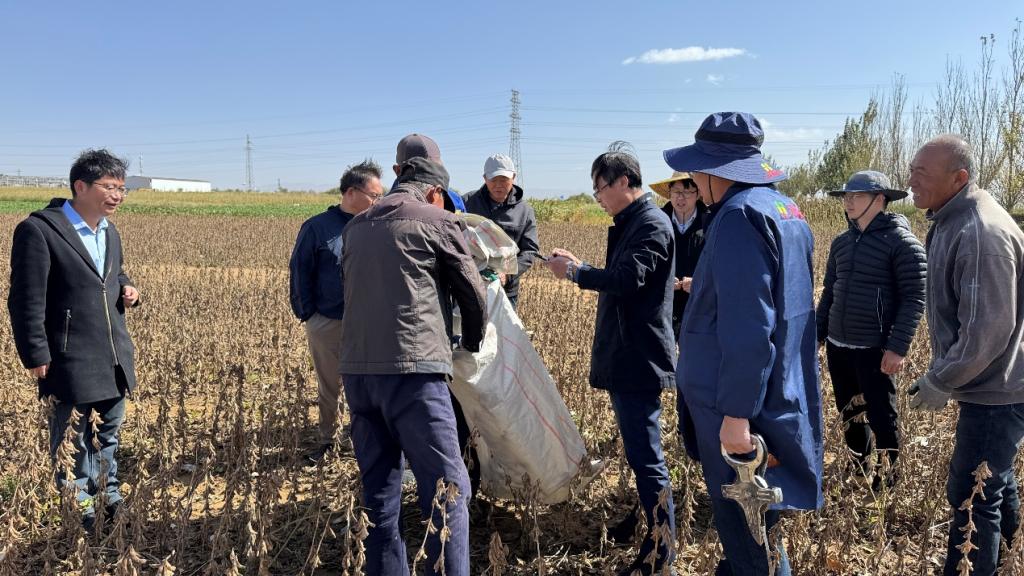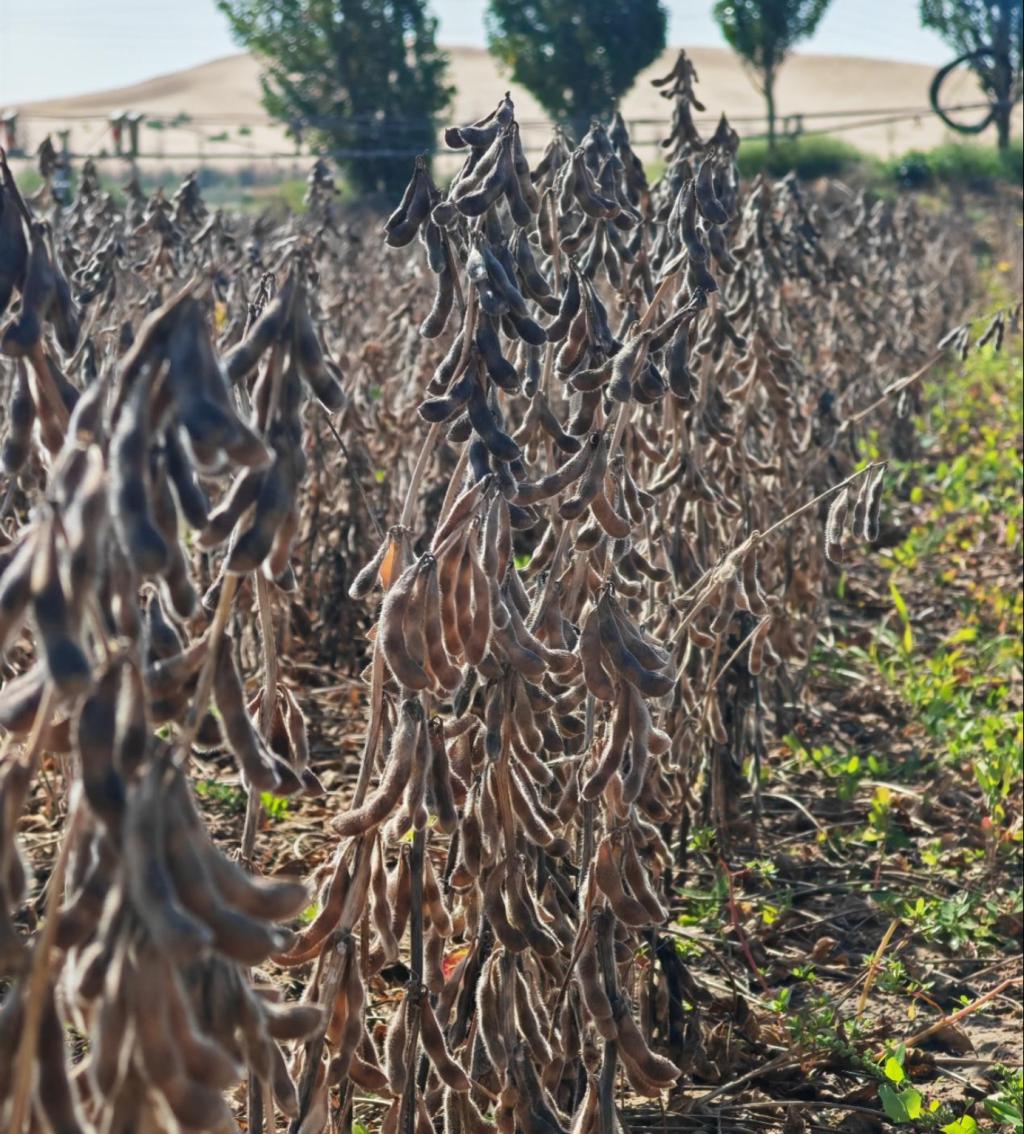Updated: November 2, 2024
To comprehensively estimate the crop yield and evaluate production efficiency of the 2024 “Desert Soilization” soybean on-farm trial, the Office of Science and Technology at Chongqing Jiaotong University(CQJTU) organized an on-site assessment from September 29 to 30. A five-member expert panel-comprising agricultural specialists from the Chongqing Academy of Agricultural Sciences, Southwest University, Bayannur Academy of Agricultural and Animal Husbandry Sciences, and the Linhe District Agricultural Technology Extension and Service Center-Conducted the yield estimation at CQJTU’s Ulan Buh Desert Soilization Pilot Experiment Site.
The panel was led by Researcher Zhang Xiaochun, Director of the Institute of Specialty Crops at the Chongqing Academy of Agricultural Sciences and Vice Chairman of the Chongqing Society of Plant Protection.
The site, built and managed by CQJTU’s Desert Soilization technology team, focuses on sand dune stabilization, soil improvement, and high-yield soybean cultivation trials. The team of experts conducted field inspections of a 30-mu (2-hectare) soybean plot within the Ulan Buh Desertification Control Ecological Industry Demonstration Area in Alxa League, Inner Mongolia. For yield estimation, they selected a 10-mu section of the soybean field. Within this area, three random sampling points (each 12 m²) were harvested for calculation. After moisture content analysis(based on the most acceptable level of 13%), the following results were obtained:
Sampling Point 1: Harvested 5.48 kg of soybeans from 12 m², yielding 313.46 kg/mu
Sampling Point 2: Harvested 5.45 kg of soybeans from 12 m², yielding 311.63 kg/mu
Sampling Point 3: Harvested 5.37 kg of soybeans from 12 m², yielding 307.06 kg/mu
The average yield across the three sampling points was 310.72 kg/mu. After applying a 0.9 moisture shrink factor, the yield was calculated at 279.64 kg/mu.

Based on the calculated results, the experts reached a consensus that the desert soilization technology has demonstrated remarkable success in soybean production. They recognized it as a major breakthrough with significant implications for food security, yield enhancement, and ecological conservation.
The panel recommended that the team continue to collect high-quality crop varieties, develop green cultivation techniques, and promote full-process mechanization, and expand the application of this technology in regions most severely affected by desertification to support sustainable soybean cultivation.

The United States is currently the world’s largest producer and exporter of soybeans. According to the Crop Production 2023 Summary released by the U.S. Department of Agriculture, total U.S. soybean production in 2023 reached 111.7 million tons, with an average yield of 225 kilograms per mu.
In comparison, data from the Ministry of Agriculture and Rural Affairs of the PRC shows that in 2023, China’s soybean planting area reached 157 million mu, with a total output of 20.84 million tons and an average yield of 133 kilograms per mu. Clearly, there remains significant potential for growth in China’s soybean production and yield.
According to China’s customs data, from October 2023 to September 2024, the country’s soybean imports exceeded 100 million tons for the first time, reaching 104.8 million tons-an increase of 6.81 million tons or 6.9% year-on-year. The average value of imports over the past three years was 96.01 million tons, making this a new historical high.
Although soybean was first domesticated by Chinese farmers and is native to China, the country is no longer the leading producer. For thousands of years, China was the world’s largest soybean producer. However, in 1954, its production was surpassed by that of the United States, and later by Brazil and Argentina, making China the fourth-largest soybean producer globally.
In 1996, China shifted from being a net exporter to a net importer of soybeans, with imports of soybeans increasing year by year. China is by far the largest importer of soybeans, with an import dependency exceeding 80%. Chinese soybean imports account for over 60% of global soybean trade, making soybeans supply a critical bottleneck for the country’s food security.
In 2023, the Ministry of Agriculture and Rural Affairs launched an initiative to improve the yield per unit area of major crops such as grains and oilseeds, issuing a three-year plan for increasing soybean yields. In 2024, China’s No.1 Central Document listed “consolidating the achievements of soybean expansion” as an important part of ensuring national food security. China’s domestic soybean planting enterprises have actively responded to the central government’s policies and the ministry’s plan, vigorously promoting production actions to expand soybean planting and increase yields. According to reports, the Beidahuang Group’s Beian Branch recently harvested 3.551 million mu of soybeans, achieving an average yield of 212.71 kilograms per mu.
The yield estimation results of the soybean planted trial at the Ulan Buh Desert Soilization Pilot Experiment Site suggest that desert soilization technology holds significant potential for expanding planting areas and increasing yields in soybean cultivation. Given China’s limited land availability, insufficient yields and high demand of soybeans, transforming desertified land into new arable land using desert soilization technology and planting high-yield soybeans will provide an effective path and a solution to address the nation’s soybean shortage issue.
Looking ahead, the Desert Soilization research team will build on the success of this trial by further advancing technological innovation to achieve new breakthroughs in both the quality and yield of soybeans. At the same time, the team will intensify efforts to promote the large-scale industrial application of Desert Soilization for soybean cultivation, contributing to national ecological security, food security, and the improvement of people’s livelihoods.